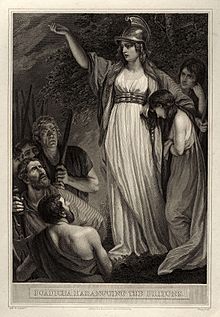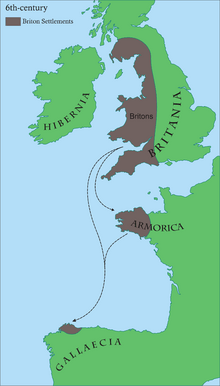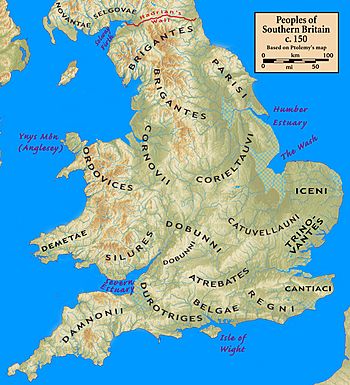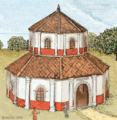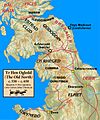Britons (Celtic people) facts for kids
The Britons (also called Brythons) were the people who spoke a Celtic language known as Common Brittonic. They lived in Great Britain during the Iron Age, Roman Britain and the Sub-Roman period following the Romans' departure from Britain. Following the arrival of the Anglo-Saxons, who occupied most what is now the country of England, some of the Britons migrated to Wales, Cornwall and southern Scotland, while others moved to Armorica and renamed it Brittany. Those who remained were absorbed into Anglo-Saxon society.
Name
In about 330 BC, Pytheas, a Greek explorer began a voyage in which he discovered the British Isles. In 326 BC he landed and gave the island the name Prettanike or Brettainiai. The name became Britain.
When the Romans conquered Britain in 43 AD, they called the people living there Brittanni (also spelled Britanni). They were also aware of their tribal . In their the Romans said of them "they are a people harassed by hosts, who receive political exiles, who rebel, and who are among the remote peoples of the world." Monks writing in the 4th and 5th centuries also called them Britanni. Some used the term Britto.
The Anglo-Saxon Chronicle contains an account of the land and the people of Britain. ""The island of Britain is eight hundred miles long and two hundred miles broad: and here are in the island five peoples: English, Brito-Welsh, Scottish, , and Book-Latin."
The Welsh scholar John Rhys first used the terms and . He wanted a more specific terms for the people of Wales and the Welsh of Cumbria and Cornwall than just the word Britons.
Celtic tribes
From the Iron Age onward, Britain was divided among a variety of Celtic tribes. When the Romans came, many of the tribes adopted Roman culture and the Latin language.
Central
- The Brigantes - Controlled what would later be much of Northern England.
- The Carvetii - Located in the area of the Solway Plain just north of Hadrian's Wall.
- The Corieltauvi - They lived in what is now the East Midlands.
- The Cornovii - Lived in what is now the West Midlands.
- The Parisii - Occupied what is now East Yorkshire.
Southeastern
- The Atrebates - Occupied what is now West Sussex, parts of Hampshire and Surrey.
- The Belgae - Were in and around the county of Hampshire.
- The Cantiaci - Lived in and gave their name to the modern county of Kent
- The Catuvellauni - Occupied what would later be Hertfordshire, Bedfordshire and Cambridgeshire.
- The Iceni - Were in area of what was later Norfolk, Suffolk, Cambridgeshire and Huntingdonshire
- The Regnenses - They occupied what would be East Sussex and Surrey.
- The Trinovantes - Controlled Essex and parts of Hertfordshire and Middlesex.
Western
- The Deceangli - Their territory included north-east Wales.
- The Demetae - Gave their name to Dyfed; also inhabited modern Pembrokeshire and Carmarthenshire.
- The Dobunni - Their territory included Northern Somerset, Bristol, and Gloucestershire.
- The Dumnonii - Occupied what would be Cornwall and Devon.
- The Durotriges - Occupied the later area of Dorset and western Hampshire.
- The Gangani - They occupied much of northwestern Wales.
- The Ordovices - They lived in northern Wales and Anglesey
- The Silures - Their territory included modern Monmouthshire, Breconshire and Glamorganshire.
Images for kids
-
The Battersea Shield, a ceremonial bronze shield dated 3rd–1st century BC, is an example of La Tène Celtic art from Britain
-
A reconstruction drawing of Pagans Hill Romano-British temple
See also
 In Spanish: Britanos para niños
In Spanish: Britanos para niños


